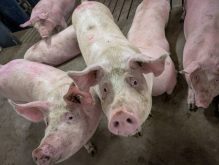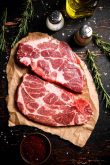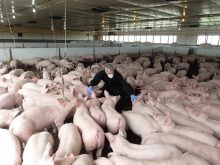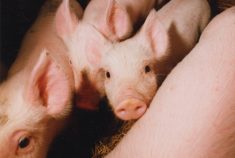The meat industry, particularly pork, is facing tough times as inflation catches up with demand.
There’s been a torrent of bad news in the meat sector in the last two months. Tyson Foods reported its first quarterly loss since 2009; HyLife’s processing plant in Windom, Minn., declared bankruptcy; Smithfield Foods is closing 40 sow farms in Missouri; Olymel Foods announced permanent closure of its Vallée-Jonction hog plant in Quebec; and despite rising sales, Maple Leaf Foods reported a loss in the first quarter of 2023.
“Everybody’s feeling the pinch, and these sorts of restructurings are a function of the economic challenges that we have right now,” says Paul Marchand, senior risk management analyst with H@ms Marketing.
Read Also

Seeding Indigenous agricultural prosperity
National Circle for Indigenous Agriculture and Food says Indigenous agricultural success needs strong relationships.
WHY IT MATTERS: Uncertainty about input costs, demand and price are making profits more difficult to achieve for many livestock producers.
Marchand singled out HyLife’s Windom plant closure as an example.
“It was purely market conditions that drove that decision,” he says. “It talked about an inflationary environment, a high-cost environment, and just difficult global economic challenges to navigate.
“The plant was losing $6 million a month, according to their bankruptcy filings. This is all a function of the economic conditions that we’re in.”
Marchand says those conditions developed as a result of policy decisions made during the pandemic.
“You can’t disrupt supply chains by asking everybody to restrict their movement. That’s going to create challenges,” he says. “And then you pump a bunch of money into the economy on both sides of the border because you’ve asked people to stay home.”
He doesn’t label that as right or wrong in terms of health policy.
“I’m not going to get into that, but it was economically very disruptive,” he says. “We are feeling the fallout of those decisions that were made in 2020, and we’ll continue to do so until we see a new normal develop.”
Marchand says that new normal won’t be realized until the effects of this inflationary, high interest rate environment are settled, but the timing of that is hard to predict.
“There is a policy lag with any of these decisions so we’re just waiting (for) the impacts of the policy to kind of catch up,” he says. “The good news is, we’ve seen a slowdown in demand and a turnaround in inflation rates. While I don’t think that we see an interest rate rise for the remainder of the year, they almost certainly are not going to cut.”
Current times signal a market correction, he says. The excess money supply caused an inflationary bump and extra dollars in circulation increased demand for higher-cost proteins, which drove up all meat prices.
Then the Bank of Canada and the U.S. Federal Reserve began raising interest rates to bring inflation under control. Companies that were over-leveraged are now feeling the pinch with higher debt-servicing costs. For the same reasons, consumers had to tighten their belts so their taste for high-priced proteins diminished.
“It’s not like you can say, ‘I don’t feel like paying my line of credit today’,” says Marchand. “But I can very easily buy ground pork instead of a loin or ground beef instead of a steak.”
The pork sector is being hit hardest by these market forces. When Maple Leaf reported its first-quarter loss, it blamed “pork market headwinds” in addition to inflationary pressures.
When demand for pork rose in 2021, the industry began producing more pigs. Now that consumers are cutting back, there’s an oversupply.
“As prices go up, sometimes producers start to increase production, perhaps a little too early,” said Stephen Heckbert, executive director of the Canadian Pork Council. “Sometimes we outpace market demand with production. And that’s the cycle we’re in at this moment.”
But Heckbert says the situation is largely self-correcting.
“There’s no perfect world where we can match the market exactly. We’re invariably either too high or too low. When we’re too low, prices go up.”
Heckbert is encouraged by recent developments in overseas markets, where roughly half of Canadian pork goes.
“We’re back in China now. The Philippines is a growing market for us now. As more people enter the middle class, pork consumption is going to grow.”
The price of hogs is determined by the U.S. domestic market, the destination for only 20 per cent of Canadian pork. So, while demand for Canadian pork in overseas markets has a negligible effect on the price producers get for hogs, it does ensure there are markets for Canadian pork when the U.S. market is oversaturated.
The beef sector has been somewhat insulated from economic pressures because producers reduced herd sizes in the face of high feed prices after several years of drought. Demand has never caught up. Now, with consumer spending choked by high interest rates and rising prices, demand will inevitably fall.

“Inflationary pressures have been a challenge for the last couple years from the input side of things in the beef space,” says Manitoba Beef Producers general manager Carson Callum, adding there is still a strong outlook for cattle prices.
“Obviously there are market headwinds that continue to be at play, and producers are monitoring those.”
He recommends that producers take advantage of risk-management programs like livestock price insurance while prices are high and coverage is favourable.
Risk management programs are also an important tool for pork producers, says Manitoba Pork general manager Cam Dahl.

He recommends that producers look into risk management tools where there’s forward contracting or forward pricing, on the feed side as well as the product side.
“That’s not always the perfect solution, but in dealing with that volatility right now, those tools are becoming more and more valuable.”
Dahl says volatility extends to the farm level.
“Whether it’s farrow to finish, if you’re just producing isoweans, or if you’re a nursery or a finisher, everybody’s losing money right now.
“Grain farmers will tell you their prices are falling, but we’re still seeing some of the highest feed prices we’ve seen in history,” says Dahl. “Unfortunately, right now, the price of a hog is falling faster than the price of feed.”
While things remain uncertain, Dahl says he doesn’t expect to see any plant closures in Manitoba.
“I’m confident that there is really a Manitoba advantage to having the processing industry here,” he says. “I don’t see that under threat.”
















